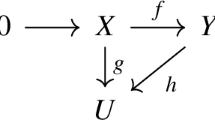Abstract
We consider pairs (K,G) of an infinite field K or a formally real field K and a group G and want to find extension fields F of K with automorphism group G. If K is formally real then we also want F to be formally real and G must be right orderable. Besides showing the existence of the desired extension fields F, we are mainly interested in the question about the smallest possible size of such fields. From some combinatorial tools, like Shelah’s Black Box, we inherit jumps in cardinalities of K and F respectively. For this reason we apply different methods in constructing fields F: We use a recent theorem on realizations of group rings as endomorphism rings in the category of free modules with distinguished submodules. Fortunately this theorem remains valid without cardinal jumps. In our main result (Theorem 1) we will show that for a large class of fields the desired result holds for extension fields of equal cardinality.
Similar content being viewed by others
References
Artin, E., Schreier, O., Algebraische Konstruktion reeler Körper, Hamburger Abhandl.5 (1927), 85–99
Baer, R., Dichte, Archimedizität und Starrheit geordneter Krper, Math. Ann.188 (1970), 165–205
Böttinger, C., Göbel, R., Endomorphism algebras of modules with distinguished partially ordered submodules over commutative rings, Jour. of Pure and Appl. Algebra76 (1991), 121–141
Cherlin, G., Model Theoretic Algebra, Selected Topics, Springer LNM521 (1970), Berlin, Heidelberg, New York
Conrad, P., Right-ordered groups, Michigan Math. J.6 (1959), 267–275
Corner, A. L. S., Göbel, R., Prescribing endomorphism algebras—a unified treatment, Proc. Lond. Math. Soc. (3)50 (1985), 447–479
Corner, A. L. S., Every countable reduced torsion-free ring is an endomorphism ring, Proc. Lond. Math. Soc. (3)13 (1964), 687–710
Corner, A. L. S., Endomorphism algebras of large modules with distinguished submodules, J. Algebra11 (1969), 155–185
Dugas, M., Göbel, R., May, W., Free modules with two distinguished submodules, submitted
Dugas, M., Thomé, B., Countable Butler groups and vector spaces with four distinguished subspaces, J. Algebra138, (1991), 249–272
Dugas M., Göbel, R., Field extensions in L—A solution of C. U. Jensen’s $25-problem. pp. 496–516 in “Abelian Group Theory,” Proceedings Oberwolfach 1985, (R. Göbel and E.A. Walker, eds.), Gordon and Breach, London, 1987
Dugas, M., Göbel, R., All infinite groups are Galois groups over any field, Trans. A.M.S.304 (1987) 355–383, Notices Amer. Math. Soc.32 (1985), 482
Franzen, B., Göbel, R., The BBC-Theorem and its application to modules, pp. 207–226 in “Abelian Group Theory”, Proceedings Oberwolfach, 1985, (R. Göbel and E.A. Walker, eds.), Gordon and Breach, London 1987
Franzen, B., Göbel, R., Prescibing endomorphism algebras—the cotorsion-free case, Rendiconti Padova80 (1988) 215–241
Fried, E., A comment on automorphism groups of fields, Studia Sci. Math. Hungar.14 (1979), 315–317
Fried E., Kollar, J., Automorphism groups of fields, Colloqu. Math. Soc. Janos Bolyai29 (1977), 293–303
Fried E., Kollar, J., Automorphism group of algebraic number fields, Math. Z.163 (1978), 121–123
Fried, M., A note on automorphism groups of algebraic number fields, Proc. Amer. Math. Soc.80 (1980), 386–388
Fuchs, L., Infinite Abelian Groups, Academic Press New York, Vol. I (1970), Vol II (1973)
Funk, M., Kegel, O. Strambach, K., Gruppenuniversalität und Homogenisierbarkeit, Annali di Mat. pura ed appl.141 (1985) 1–126
Teyer, W. D., Jede endliche Gruppe ist Automorphismengruppe einer endlichen ErweiterungK│Q Arch. Math.41 (1983), 139–142
Göbel, R., Modules with distinguished submodules, in “Abelian Group Theory,” Proceedings of the Curacao Conference 1991, Marcel and Dekker, 1993, pp. 55–64
Göbel, R., May, W., Four submodules suffice for realizing algebras over commutative rings, Journ. Pure and Appl. Algebra65 (1990), 29–43
Göbel, R., May, W., Independence in completions and endomorphism algebras, Forum Math.1 (1989), 215–226
Jacobson, N., Lectures in Algebra, Vol. III, Theory of fields and Galois theory, Van Nostrand, New York 1964
Kaplansky, I., “Fields and Rings,” The University of Chicago Press, Chicago, London 1965
Lang, S., Algebra, Addison-Wesley, Publ. Company, Reading, Mass. 1965
Prestel, A. Lectures on formally real fields, Springer, LNM1093 (1984), Berlin, Heidelberg, New York
Pröhle, P., Does the Frobenius endomorphism always generate a direct summand in the endomorphism monoid of prime characteristic, Bull. Austral. Math. Soc.30 (1984), 335–356
Pröhle, P., Does a given subfield of characteristic zero imply any restriction to the endomorphism monoids of fields? Acta Sci. Math.50 (1986), 15–38
Ringel, C. M., Tachikawa, H., QF-3 rings, J. Reine Angewandte Math.272 (1975), 49–72
Scott, D., On completing ordered fields, pp. 274–278 in “Applications of model theory to algebra, analysis and probability,” Proc. Intern. Sympos. of the Institute of Technology, Calif., Ed. W. A. J. Luxemburg, Holt-Rinehart and Winston, New York 1969
Shelah, S., Existence of rigid-like families of abelian p-groups, pp. 384–402 in “Model Theory and Algebra,” Lectures Notes in Mathematics, vol.498, Springer-Verlag, Berlin and New York, 1975
Shelah, S., A conbinatorial principle and endomorphism rings I. On p-groups. Israel J. of Math.49 (1984), 239–257
Shelah, S., A combinatorial principle and endomorphism rings of abelian groups II. pp. 37–86 in “Abelian Groups and Modules,” Proceeding Udine conference, (R. Göbel, C. Metelli, A. Orsatti, and L. Salce, eds.), CISM. Courses and Lectures, vol.287, Springer, Wien, 1984
Simson, D., Functor categories in which every flat object is projective, Bull. Acad. Polon. Ser. Math.22 (1974), 375–380
Simson, D., Linear representations of partially ordered sets and vector space categories, Gordon and Breach, London 1992
van der Waerden, B. L., Algebra I, Springer, Berlin, Göttingen, Heidelberg 1960
Author information
Authors and Affiliations
Additional information
This article was processed by the author using the LATEX style filecljour1 from Springer-Verlag
Rights and permissions
About this article
Cite this article
Dugas, M., Göbel, R. Automorphism groups of fields. Manuscripta Math 85, 227–242 (1994). https://doi.org/10.1007/BF02568195
Received:
Revised:
Issue Date:
DOI: https://doi.org/10.1007/BF02568195



